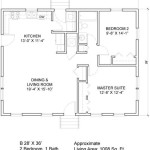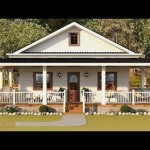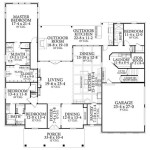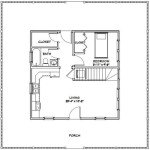House plans with separate living quarters, often referred to as multigenerational house plans or accessory dwelling units (ADUs), are becoming increasingly popular as homeowners seek additional space for extended family members, aging parents, or adult children. These types of house plans feature two or more distinct living areas within a single home, providing privacy and independence for multiple generations or occupants.
For example, a house plan with separate living quarters might include a main house with three bedrooms, two bathrooms, and a kitchen, as well as a smaller attached or detached unit with one bedroom, one bathroom, and a kitchenette. The separate unit could serve as a private living space for elderly parents or adult children returning home, offering them their own space while still maintaining close proximity to family.
When considering house plans with separate living quarters, there are several important points to keep in mind:
- Privacy and independence: Separate living quarters provide privacy and independence for multiple generations or occupants.
- Flexibility: They offer flexibility to accommodate changing family needs, such as aging parents or adult children returning home.
- Aging in place: Separate living quarters can support aging in place, allowing elderly family members to maintain their independence while being close to loved ones.
- Rental income: Renting out the separate unit can provide additional income to offset mortgage costs.
- Resale value: Homes with separate living quarters are often more desirable to buyers, increasing resale value.
- Space planning: Careful space planning is essential to ensure both privacy and accessibility.
- Accessibility: Consider accessibility features such as wheelchair ramps or walk-in showers if the separate unit is intended for elderly occupants.
- Separate entrances: Separate entrances for each living area provide added privacy and convenience.
- Shared amenities: Deciding which amenities, such as laundry facilities or outdoor space, will be shared can help optimize space and resources.
By carefully considering these points, homeowners can create house plans with separate living quarters that meet the unique needs of their families and provide comfortable and functional living spaces for all occupants.
Privacy and independence: Separate living quarters provide privacy and independence for multiple generations or occupants.
One of the key advantages of house plans with separate living quarters is the privacy and independence they provide for multiple generations or occupants. Each living area can have its own separate entrance, bedrooms, bathrooms, and kitchen, allowing occupants to maintain their own space and privacy while still being close to loved ones.
For example, elderly parents living in a separate unit attached to their children’s home can enjoy their own private living space, complete with a bedroom, bathroom, and kitchenette. They can come and go as they please, without feeling like they are imposing on their children’s space. At the same time, they are close by if they need assistance or want to spend time with their family.
Similarly, adult children returning home after college or a period of living independently can appreciate the privacy and independence of having their own separate living quarters. They can have their own space to entertain friends, work on projects, or simply relax without disturbing the rest of the household.
Separate living quarters can also provide a sense of security and independence for occupants who may have different needs or lifestyles. For example, an elderly parent with limited mobility may feel more comfortable and secure in a separate unit that is designed to meet their specific needs, such as a unit with wider doorways, grab bars, and a walk-in shower. Similarly, an adult child with a busy social life may appreciate having their own separate space where they can come and go without disturbing the rest of the household.
In summary, house plans with separate living quarters offer a unique solution for families who want to live together while maintaining their privacy and independence. Whether it’s for aging parents, adult children, or other family members, separate living quarters provide a comfortable and functional living space that meets the needs of multiple generations or occupants.
Flexibility: They offer flexibility to accommodate changing family needs, such as aging parents or adult children returning home.
House plans with separate living quarters offer a high degree of flexibility to accommodate changing family needs over time. As families grow and change, the separate living quarters can be easily adapted to meet new needs.
- Aging parents: As parents age, they may require additional care and assistance. Separate living quarters can provide a safe and comfortable space for elderly parents to live independently while still being close to family. The separate unit can be designed to meet their specific needs, such as wider doorways, grab bars, and a walk-in shower. This allows them to maintain their independence and dignity while having peace of mind knowing that family is nearby.
- Adult children returning home: After college or a period of living independently, adult children may return home for a variety of reasons. Separate living quarters can provide them with a private and independent space to live, without feeling like they are imposing on their parents’ space. This can be especially helpful for adult children who are starting their careers, saving for a home, or simply want to be closer to family.
- Multigenerational living: House plans with separate living quarters can accommodate multigenerational living arrangements, where multiple generations of a family live together under one roof. This can be a great way to provide support and care for elderly parents, while also allowing younger generations to benefit from the wisdom and experience of their elders. Separate living quarters ensure that each generation has their own private space and independence, while still being able to come together for family meals, activities, and celebrations.
- Rental income: Separate living quarters can also be used to generate rental income, which can help offset the cost of the mortgage or provide additional financial security. Renting out the separate unit can be a good option for families who have extra space and are looking for a way to supplement their income.
In summary, house plans with separate living quarters offer a flexible and adaptable solution for families who want to accommodate changing family needs over time. Whether it’s for aging parents, adult children returning home, multigenerational living, or rental income, separate living quarters provide a comfortable and functional living space that can be easily adapted to meet the needs of the family.
Aging in place: Separate living quarters can support aging in place, allowing elderly family members to maintain their independence while being close to loved ones.
As people age, they may eventually reach a point where they need additional care and support. For some, this may mean moving to a nursing home or assisted living facility. However, many seniors prefer to age in place, remaining in their own homes and communities for as long as possible.
Separate living quarters can play a vital role in supporting aging in place. By providing elderly family members with their own private and independent living space, while still being close to loved ones, separate living quarters can help them maintain their independence and quality of life.
- Safety and security: Separate living quarters can provide a safe and secure environment for elderly family members. The unit can be designed to meet their specific needs, such as wider doorways, grab bars, and a walk-in shower. This can help to reduce the risk of falls and other accidents.
- Privacy and independence: Separate living quarters allow elderly family members to maintain their privacy and independence. They can come and go as they please, and they have their own space to entertain guests or pursue their hobbies.
- Proximity to family: Separate living quarters allow elderly family members to be close to their loved ones. This can provide them with peace of mind knowing that they are not alone, and it can also make it easier for family members to provide care and support as needed.
- Cost-effective: Separate living quarters can be a more cost-effective option than moving to a nursing home or assisted living facility. In addition, many insurance policies cover the cost of home modifications that are necessary for aging in place.
In summary, separate living quarters can provide a valuable solution for families who want to support their elderly loved ones in aging in place. By providing a safe, secure, and independent living space, while still being close to family, separate living quarters can help seniors maintain their quality of life and independence for as long as possible.
Rental income: Renting out the separate unit can provide additional income to offset mortgage costs.
Renting out the separate unit in a house plan with separate living quarters can be a great way to generate additional income to offset mortgage costs. This can be especially beneficial for homeowners who are looking to supplement their income, pay down their mortgage faster, or save for future expenses.
There are a few things to consider when renting out a separate unit. First, it’s important to check local zoning laws to make sure that renting out the unit is permitted. Second, you’ll need to decide how much rent to charge. You’ll want to research rental rates in your area to determine a fair price. Third, you’ll need to create a rental agreement that outlines the terms of the lease, including the rent amount, due date, and any other relevant information.
Once you’ve rented out the unit, it’s important to be a responsible landlord. This means responding to tenant requests promptly, making sure the unit is well-maintained, and following all applicable laws and regulations.
Renting out the separate unit in a house plan with separate living quarters can be a great way to generate additional income and offset mortgage costs. However, it’s important to do your research and make sure that you’re prepared to be a responsible landlord.
Resale value: Homes with separate living quarters are often more desirable to buyers, increasing resale value.
Homes with separate living quarters are often more desirable to buyers, which can lead to a higher resale value. There are several reasons for this:
- Multi-generational living: As the population ages, there is a growing demand for homes that can accommodate multiple generations under one roof. Separate living quarters provide the perfect solution for this, as they allow elderly parents or adult children to live independently while still being close to family.
- Rental income: As mentioned earlier, renting out the separate unit can provide additional income to offset mortgage costs. This can be a major selling point for buyers who are looking for a home that can generate rental income.
- Flexibility: Separate living quarters offer a high degree of flexibility to accommodate changing family needs. As families grow and change, the separate living quarters can be easily adapted to meet new needs, such as aging parents, adult children returning home, or multigenerational living.
- Privacy and independence: Separate living quarters provide privacy and independence for multiple generations or occupants. Each living area can have its own separate entrance, bedrooms, bathrooms, and kitchen, allowing occupants to maintain their own space and privacy while still being close to loved ones.
In summary, homes with separate living quarters are often more desirable to buyers because they offer a number of advantages, including multi-generational living, rental income, flexibility, and privacy. As a result, homes with separate living quarters often have a higher resale value than homes without separate living quarters.
Space planning: Careful space planning is essential to ensure both privacy and accessibility.
When designing house plans with separate living quarters, careful space planning is essential to ensure both privacy and accessibility. The goal is to create a layout that provides each living area with its own private space, while still allowing for easy access to shared amenities and common areas.
- Define separate entrances: Each living area should have its own separate entrance, providing privacy and independence for occupants. This is especially important for elderly parents or adult children who may want to come and go without disturbing the rest of the household.
- Create private outdoor spaces: If possible, each living area should have its own private outdoor space, such as a patio or balcony. This provides occupants with a place to relax and enjoy the outdoors without having to share space with other household members.
- Plan for shared amenities: If certain amenities, such as a laundry room or home gym, will be shared between living areas, careful planning is needed to ensure that each living area has easy access to these amenities without having to go through the other living area.
- Consider accessibility needs: If the separate living quarters are intended for elderly occupants or occupants with disabilities, accessibility features should be incorporated into the design. This may include wider doorways, grab bars, and walk-in showers.
By carefully considering space planning, homeowners can create house plans with separate living quarters that provide both privacy and accessibility for all occupants.
Accessibility: Consider accessibility features such as wheelchair ramps or walk-in showers if the separate unit is intended for elderly occupants.
When designing separate living quarters for elderly occupants, it is essential to consider accessibility features that will allow them to live independently and safely. Some important accessibility features to consider include:
- Wheelchair ramps: If the separate unit is located on a different level than the main house, a wheelchair ramp will be necessary to ensure that elderly occupants can access the unit safely and independently.
- Walk-in showers: Walk-in showers are a great option for elderly occupants, as they are easy to enter and exit, and they eliminate the risk of slipping and falling.
- Grab bars: Grab bars can be installed in bathrooms, showers, and other areas of the separate unit to provide support and stability for elderly occupants.
- Wider doorways: Wider doorways will allow elderly occupants to easily navigate the unit with a wheelchair or walker.
- Lever handles: Lever handles are easier to use for elderly occupants than traditional doorknobs.
By incorporating these accessibility features into the design of the separate living quarters, homeowners can create a safe and comfortable living environment for their elderly loved ones.
In addition to the accessibility features listed above, there are a number of other design elements that can be incorporated into the separate living quarters to make it more accessible and comfortable for elderly occupants. These include:
- Single-story design: A single-story design will eliminate the need for stairs, making it easier for elderly occupants to move around the unit.
- Open floor plan: An open floor plan will create a more spacious and accessible living environment for elderly occupants.
- Non-slip flooring: Non-slip flooring will help to reduce the risk of falls.
- Good lighting: Good lighting will help to prevent accidents and falls.
By carefully considering the accessibility needs of elderly occupants, homeowners can create separate living quarters that are both safe and comfortable.
Separate entrances: Separate entrances for each living area provide added privacy and convenience.
One of the key benefits of house plans with separate living quarters is that they can have separate entrances for each living area. This provides added privacy and convenience for occupants, as they can come and go without having to go through the other living area.
For example, elderly parents living in a separate unit attached to their children’s home can have their own private entrance, allowing them to come and go as they please without disturbing their children. Similarly, adult children returning home after college or a period of living independently can appreciate the privacy and convenience of having their own separate entrance, so they can come and go without having to go through their parents’ living area.
Separate entrances can also be beneficial for multigenerational living arrangements, as they allow each generation to have their own private space and independence. For example, grandparents living in a separate unit on the first floor can have their own private entrance, while their adult children and grandchildren living on the second floor can have their own separate entrance.
In addition to providing privacy and convenience, separate entrances can also improve the overall security of the home. By having separate entrances for each living area, occupants can control who has access to their living space, and they can also more easily monitor who is coming and going from the home.
Overall, separate entrances for each living area provide added privacy, convenience, and security for occupants of house plans with separate living quarters.
Shared amenities: Deciding which amenities, such as laundry facilities or outdoor space, will be shared can help optimize space and resources.
When designing house plans with separate living quarters, one important consideration is which amenities will be shared between the living areas. This can include amenities such as laundry facilities, outdoor space, and storage space. Carefully considering which amenities to share can help to optimize space and resources, and it can also help to create a more cohesive and functional living environment.
- Laundry facilities: Laundry facilities are a necessity in any home, but they can take up a lot of space. If the separate living quarters are small, it may not be feasible to have separate laundry facilities for each living area. In this case, it may be more efficient to have shared laundry facilities, such as a laundry room in the basement or garage.
- Outdoor space: Outdoor space is another important amenity to consider, especially if the separate living quarters are located in an urban area where outdoor space is limited. If there is not enough space for each living area to have its own private outdoor space, it may be possible to create a shared outdoor space, such as a patio or deck. This can be a great way for occupants to enjoy the outdoors without having to leave the property.
- Storage space: Storage space is often at a premium in separate living quarters, so it is important to carefully consider how storage space will be shared. One option is to have shared storage space in the basement or garage. Another option is to have each living area have its own designated storage space, such as a closet or pantry.
- Other amenities: Other amenities that may be shared between living areas include a home gym, a media room, or a guest room. When deciding which amenities to share, it is important to consider the needs of the occupants and the amount of space that is available.
By carefully considering which amenities to share, homeowners can create house plans with separate living quarters that are both efficient and functional. Shared amenities can help to save space and resources, and they can also help to create a more cohesive and connected living environment.










Related Posts








